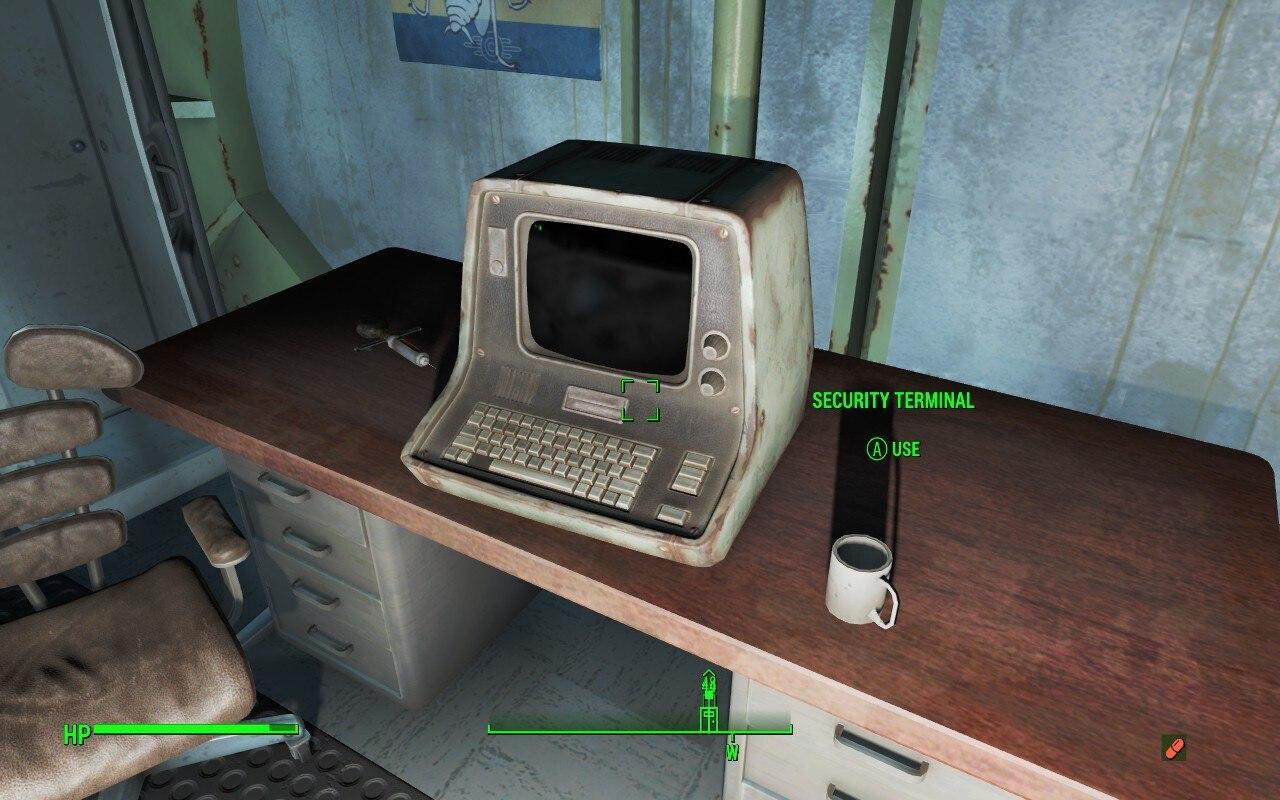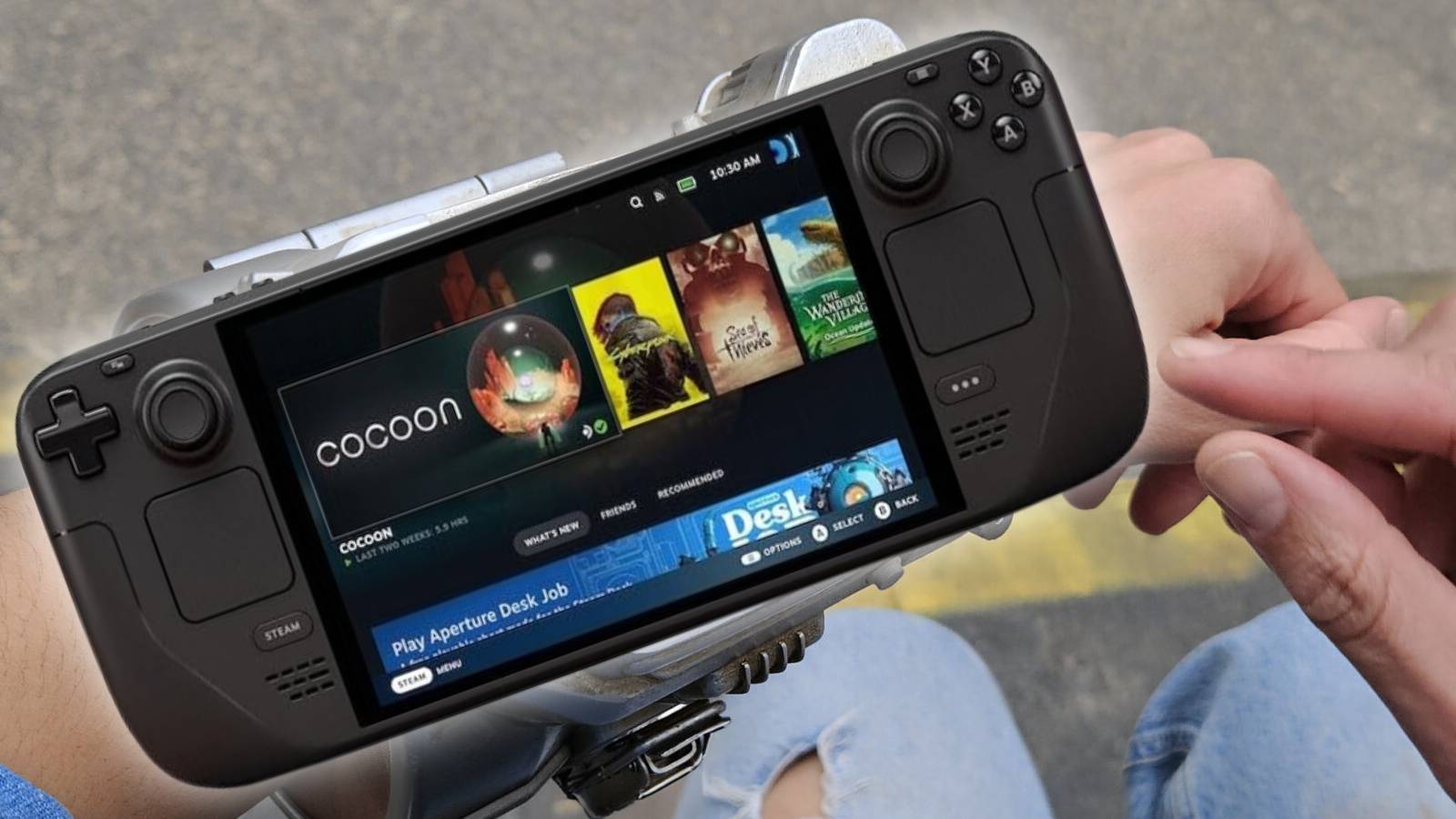Razer Blade 16 (2023) review: Unlimited power
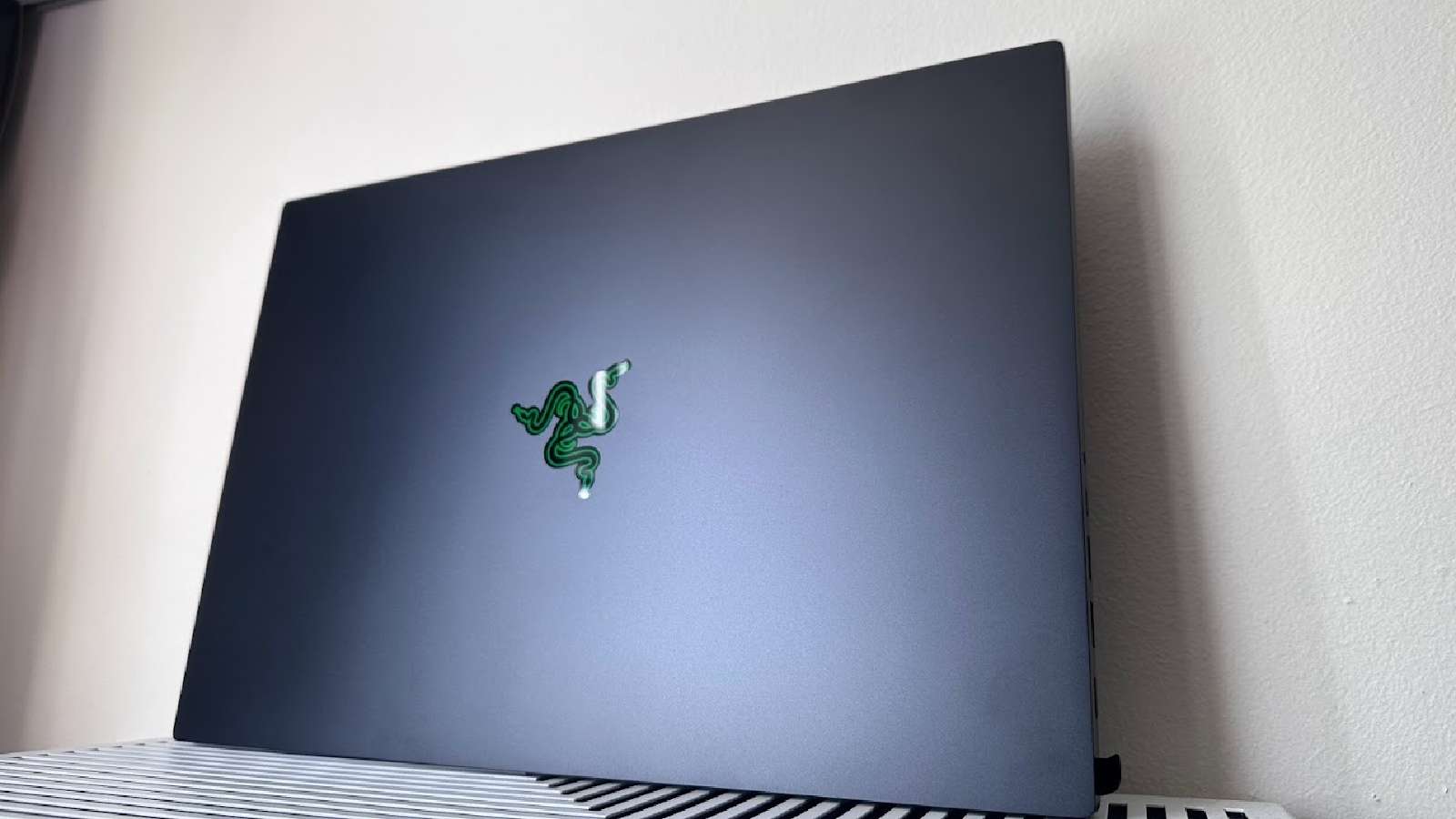 Dexerto
DexertoThe Razer Blade lineup got a bit of a shakeup this year, and we’ve had our hands on a tricked-out Blade 16 with a laptop RTX 4090 and an Intel i9-13950HX.
The Razer Blade 16 is a brand-new product for Razer. The company’s Blade lineup previously consisted of 15 and 17-inch models, which have now been slightly upgraded after a reveal at CES 2023. Historically, the gaming laptop has commanded a higher price point than others on the market, and the Blade 16 we’re looking at is no different.
Not only that but the Razer Blade 16 also houses brand-spanking-new parts like an RTX-40 series GPU and Intel Raptor Lake CPU. So, the Razer Blade 16 promises incredible power, but does it come at the cost of portability?
Key specs
- CPU: Intel Core i9-13950HX (24 core, 32 thread, up to 5.5GHz)
- RAM: 32 GB DDR5-5600MHz
- GPU: Nvidia GeForce RTX 4090 (16GB GDDR6, 175W)
- Display: 16-inch 16:10 Mini LED (UHD 120Hz & FHD 240Hz dual-mode)
- Battery: 95.2 Whr (330W power adapter)
- Storage: 2x 1TB PCIe 4.0 NVMe SSD
- Operating System: Windows 11 Home
- IO: 1x Thunderbolt 4 port, 1x USB 3.2 Gen 2 Type-C, 3x USB 3.2 Gen 2 Type-A ports, 1x HDMI 2.1 port, WiFi 6E, UHS-II SD Card reader, 3.5mm combo jack
- Features: Anodized Aluminum unibody chassis, vapor chamber cooling, glass trackpad.
- Price: $4,299.99
Design
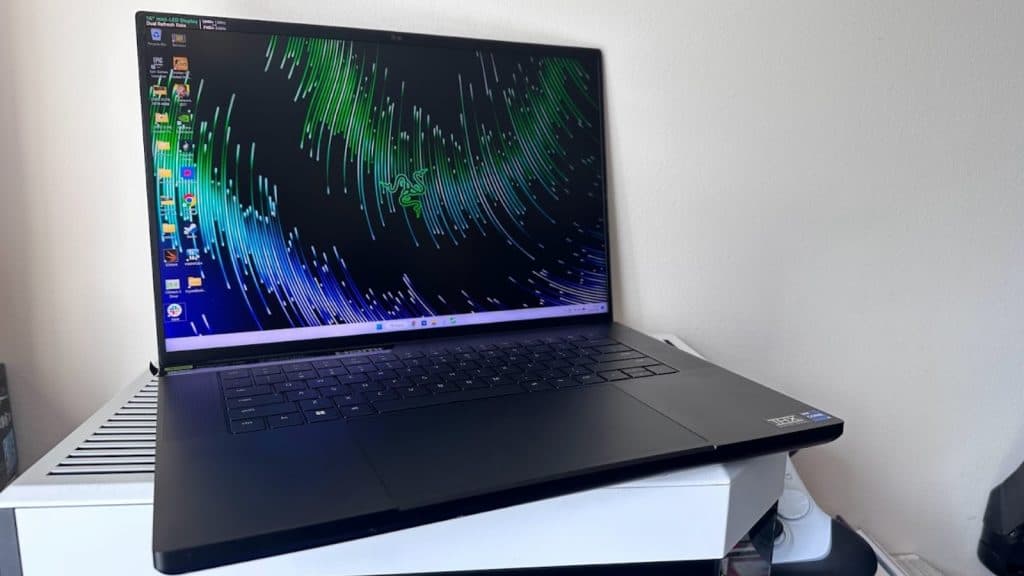 Dexerto
Dexerto If nothing else, the Razer Blade 16 is downright gorgeous. The aluminum unibody chassis reminds us of Apple’s Macbooks but colored in black. The matte black finish of the chassis is adorned with Razer’s logo, which glows while the device is powered on. Many laptops aspire to ape Apple’s designs, but for our money, no one is really offering a chassis as nice as this on a Windows machine as Razer is. Though, the matte black finish means that as soon as you put your hands on it, it manages to look messy and smudged in a matter of seconds. The same goes for dust accumulation on the system, which is only more pronounced by its finish.
There’s a slightly chamfered edge on the front, which allows you to easily open the laptop up with a single hand, which is sometimes taken for granted when looking at laptops with less well-thought-out designs. The Razer Blade 16 also houses a healthy dose of IO on the right and left-hand sides of the laptop, too. The sheer number of ports, in addition to the Thunderbolt 4 compatibility makes the Blade 16 a fantastic option for those looking to get a portable, powerful workstation PC.
Included is a 1080p camera with support for Windows Hello, in addition to a slider, which is becoming increasingly commonplace for those who value privacy. Additionally, the THX-certified speakers sound adequate, though as ever with speakers in a form factor like this, they could stand to sound a little deeper. But, this is relatively minor, and they sound fantastic otherwise.
Trackpad & keyboard
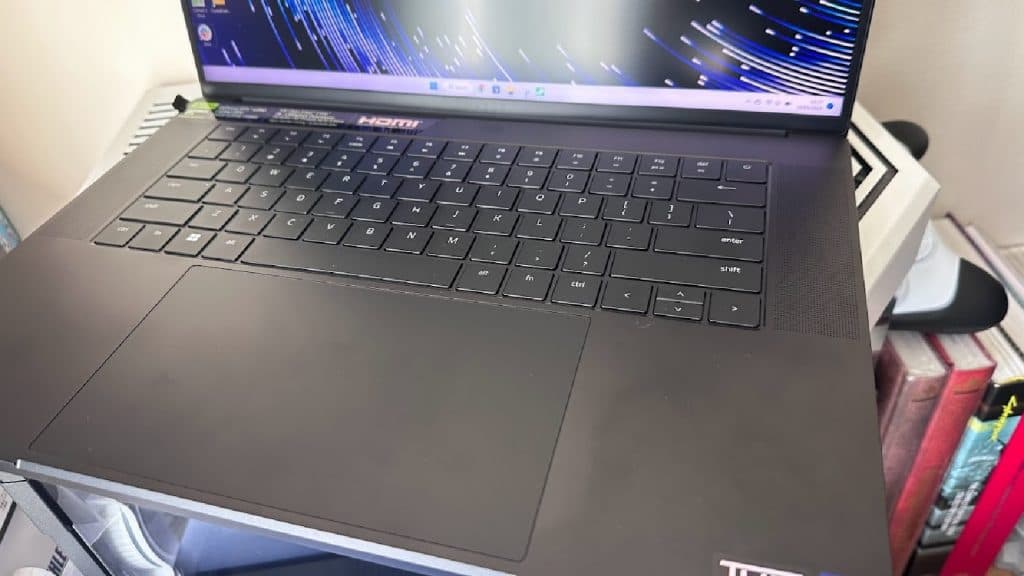 Razer
RazerOne thing that Windows laptops can’t ever seem to get quite right is the trackpad, though the Razer Blade 16’s trackpad is enormous and lovely to use, it still feels slightly off when compared to the majesty of the MacBook lineup. Though with that said, it’s probably the best trackpad we have ever used on a Windows laptop.
We also enjoyed using the chiclet-style keyboard the Blade 16 uses. Each key can be individually lit with RGB. When booting up a supported game, the RGB profiles are able to automatically switch to match the game, as we found while booting up Cyberpunk 2077. This gives the Razer Blade 16 a nice little premium touch that you really cannot find elsewhere.
The ideal size
The Razer Blade 16 is surprisingly portable, given that everything it houses in the chassis. Coming in at a familiar form factor for 15-inch laptops, the Blade 16 weighs just over 2.4kg, making the laptop surprisingly portable. The system also manages to maintain compatibility with just about every other 15-inch laptop case on the market, too.
Though, one thing that you need to consider is the behemoth of a 330W power brick that the laptop comes with. Though it can deliver a huge wattage thanks to its gallium nitride technology, it’s still bulky, and uncomfortable to haul around with you. You can charge via USB-C up to 100 watts, though your mileage with it actually being useful on a configuration this powerful may vary.
Dual display tech
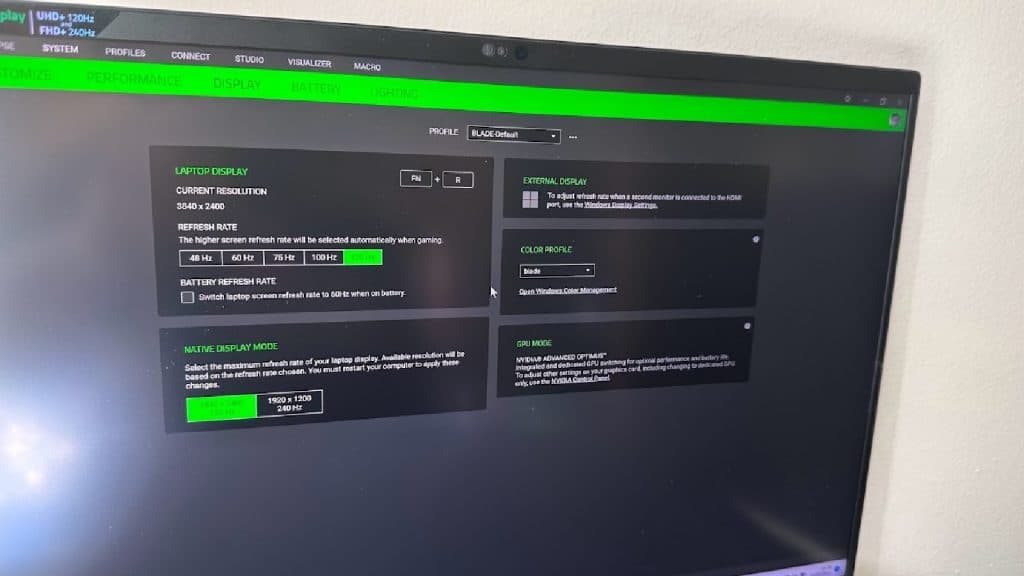 Dexerto
Dexerto One of the most unique parts of the Razer Blade 16 is its “dual display” technology. You can switch between resolutions and refresh rates with a simple restart, and it can come in handy when you are looking to drive more frames out from games.
Through Synapse, you can also configure a default refresh rate that can also go down to 48Hz, if you’re so inclined. Though the display itself is absolutely gorgeous, the Mini LED technology really shines through, with a brilliant contrast ratio and true-to-life colors. Though, we did find that when Nvidia Optimus switched over to the GPU, and away from integrated graphics, the screen did tint slightly greener, for whatever reason, which was slightly offputting.
With the display in UHD mode, everything from text to games was crystal clear- we think it might just be our favorite display on a laptop. The responsiveness of the display is simply miles ahead of the ghosting present on the Macbook Pro lineup.
Performance
As you would expect from a laptop this powerful, you should be able to throw almost any workload at it, and the Razer Blade 16 will simply grind it into dust. We installed Nvidia’s gaming drivers, though you do have access to studio drivers for content creation purposes. The strength of this laptop makes it one of the most powerful laptops ever created, and even bests many dedicated gaming PCs, as we found throughout our benchmarking process.
We benchmarked the laptop against our testbench “fastest esports gaming PC” system, which contains the following parts.
- CPU: Intel Core i5-13600K
- CPU cooler: Cooler Master PL360 Flux
- Motherboard: ASUS ROG Z790 Maximus Extreme
- RAM: ADATA XPG Lancer RGB 32GB DDR5-6000
- Storage: Sabrent Rocket 4 Plus 4TB
- Case: Hyte Y60
- PSU: EVGA Supernova GT 1300
Synthetic Benchmarks
| 3DMark | Razer Blade 16 (2023) | RTX 4070 Ti | RTX 4080 | RX 7900 XT |
| Time Spy Extreme | 9279 | 11015 | 14028 | 12979 |
| Port Royal | 11980 | 14230 | 17829 | 13074 |
| Speed Way | 4951 | 5471 | 7179 | 4697 |
When putting the Razer Blade 16 through 3DMark’s synthetic benchmarking suite, we can observe that the humble laptop manages to perform around as well as a desktop-class RTX 3090 Ti-based system. It doesn’t quite match up to our RTX 4070 Ti desktop PC, and trades blows in certain ray-traced performance workloads compared to AMD’s desktop-class graphics cards.
These results are an impressive feat, considering that the Blade 16 comes in such a portable form factor.
Razer Blade 16 4K gaming performance
| Game | Razer Blade 16 (2023) | RTX 4070 Ti | RTX 4080 | RX 7900 XT |
| Forza Horizon 5 (Ultra) | 115 FPS | 123 FPS | 137 FPS | 107 FPS |
| Cyberpunk 2077 (Ultra, RT Ultra, DLSS Performance, Frame Generation / FSR ) | 68 FPS | 89 FPS | 108 FPS | 44 FPS |
| Cyberpunk 2077 (Ultra, RT Ultra, DLSS off) | 16 FPS | 29 FPS | 29 FPS | 16 FPS |
| CS:GO (High, Dust 2) | 194 FPS | 264 FPS | 399 FPS | 340 FPS |
| Overwatch 2 (Ultra) | 344 FPS | 272 FPS | 446 FPS | 308 FPS |
Given that the Razer Blade 16 is able to make use of its gorgeous 4K display, we tested a range of games, where the Blade 16 managed to absolutely shine. Getting over 60 FPS in a performance-heavy title such as Cyberpunk 2077 is an astonishing feat, considering that the GPU is only taking up around 175W of power.
The power you get in a form factor that you can take around with you is astonishing, though we’d suggest that you mainly do any performance-heavy workloads while plugged in. On battery, the system does have slightly lower results, and it will kill battery performance significantly.
Razer Blade 16 1440p gaming performance
| Game | Razer Blade 16 (2023) | RTX 4070 Ti | RTX 4080 | RX 7900 XT |
| Forza Horizon 5 (Ultra) | 107 FPS | 147 FPS | 161 FPS | 121 FPS |
| Cyberpunk 2077 (Ultra, RT Ultra, DLSS Performance, Frame Generation / FSR ) | 126 FPS | 161 FPS | 181 FPS | 60 FPS |
| Cyberpunk 2077 (Ultra, RT Ultra, DLSS off) | 38 FPS | 47 FPS | 63 FPS | 31 FPS |
| CS:GO (High, Dust 2) | 275 FPS | 399 FPS | 399 FPS | 399 FPS |
| Overwatch 2 (Ultra) | 344 FPS | 404 FPS | 512 FPS | 406 FPS |
1440p benchmarks are where the Razer Blade 16 really shines, with almost every title (barring Cyberpunk 2077’s brutal ray tracing benches) attaining over 100 FPS. Given that the Blade 16’s dual-mode display manages also offers a 240Hz 1080p mode, you could potentially supersample titles at up to 1440p and still manage to attain excellent gaming performance. It’s frankly ludicrous, especially considering that again, you can take this device up and around with you.
Thermal performance
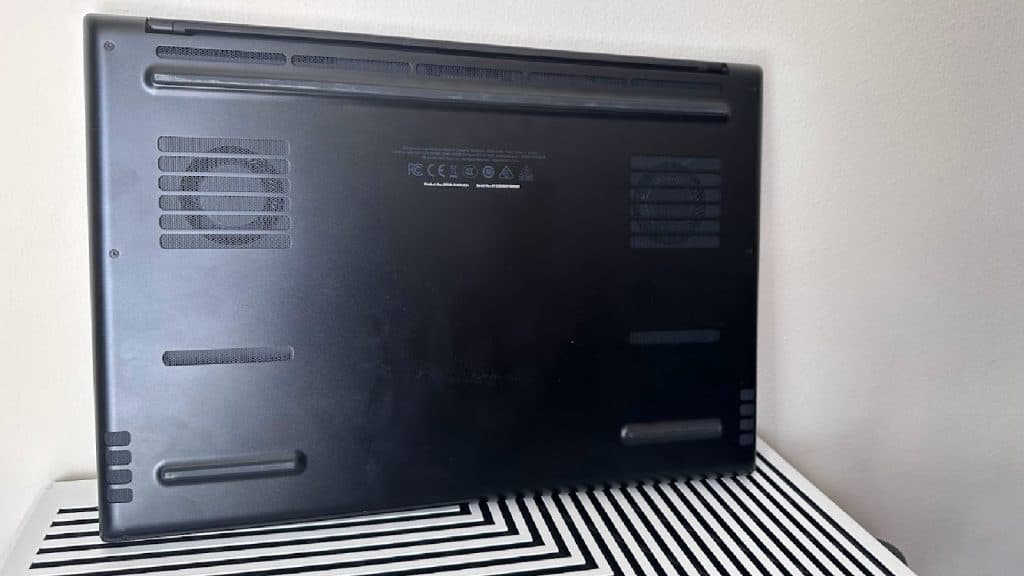 Dexerto
Dexerto The Razer Blade 16, when you put a big enough workload onto it, gets uncomfortably hot. Under the most extreme workloads, the Razer Blade can reach 100 degrees internally. This might seem alarming, but all the parts housed within are built to resist that heat. However, we did observe that the laptop did begin to throttle its clock speeds on the CPU and GPU when thermal thresholds are met. This is the unfortunate reality of a high-powered gaming laptop, as with all that power, comes a sacrifice in both heat and battery life.
Battery life & power consumption
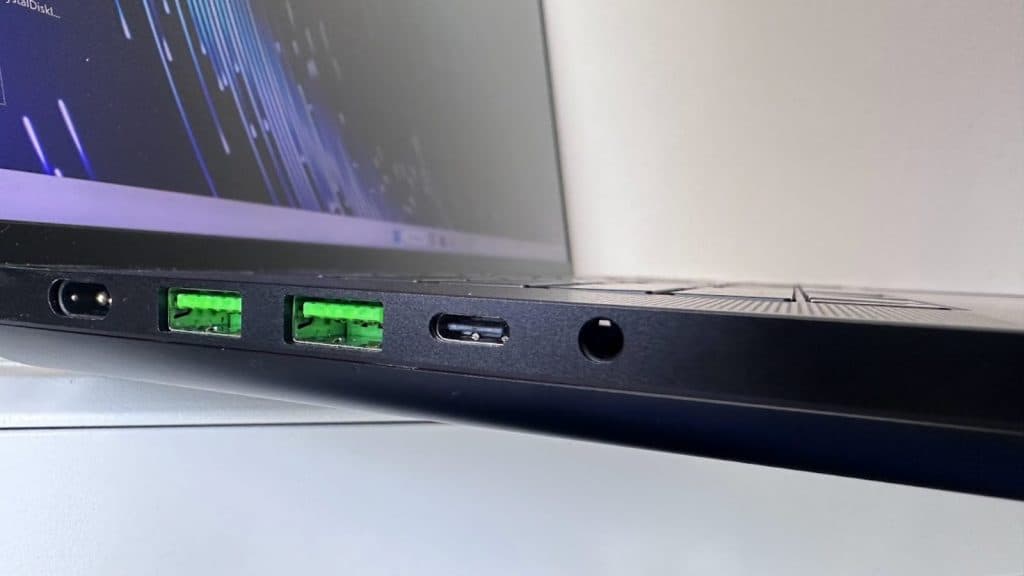 Dexerto
Dexerto Razer’s Blade 16 might have supremely powerful hardware, but it also takes a lot to power all of that x86 hardware. The top-spec version that we have can pull around 70 watts passively, especially while the GPU is active. Thanks to Nvidia Optimus, you can switch between the integrated graphics within the CPU and the dedicated 4090 on the fly. But, this still doesn’t make a huge difference as the CPU is what is drawing the most amount of power passively.
In a single session, we managed to get around two hours of use out of the laptop with the system running at 120Hz at a UHD resolution. You can use Razer Synapse to cut the refresh rate down to conserve some battery, but you do sacrifice the buttery-smoothness, too. If you wanted to be really conservative, you can also switch over to the FHD display at 60Hz.
For those looking to game using the laptop, expect huge battery drain in a short amount of time. While it’s good to game in short bursts, you shouldn’t look to use it for longer sessions. We barely managed over an hour of gaming using Cyberpunk 2077.
Though you can also restrict power usage while on battery, but that also comes at the cost of power.
Should you buy it?
We experienced little to no issues while testing the Razer Blade 16. Razer’s Synapse software is mature enough to know what’s going on, and this complex and intricate piece of hardware is marvelous, from a certain standpoint. However, we would only recommend the system for those looking for a desktop replacement system, as the battery life is not suited to a “normal” working day.
Though, for those into content creation, you’ll struggle to find a laptop that’s as well-designed in terms of appearance, performance, and power. This is the ideal workstation setup for those who require heaps of power. So, despite its flaws, the Razer Blade 16 might just be one of the best gaming laptops ever created.
The verdict – 4/5
The Razer Blade 16 is an engineering marvel, however, it also highlights its own limitations in the process. You can check your emails on it for a few hours, but never expect a full working day out of it, but that’s just the reality of the technology available in 2023. Its eye-watering price is justified by its sheer strength in build quality, something seldom seen in many other, inferior gaming laptops.
So, if you’re the type of person that wants the best gaming experience available, without the hassle of building a PC, and you might want to use it on the sofa every so often, the Blade 16 might be for you. Just remember that you’ll be paying very dearly for the privilege.
If you click on a product link on this page we may earn a small affiliate commission.


